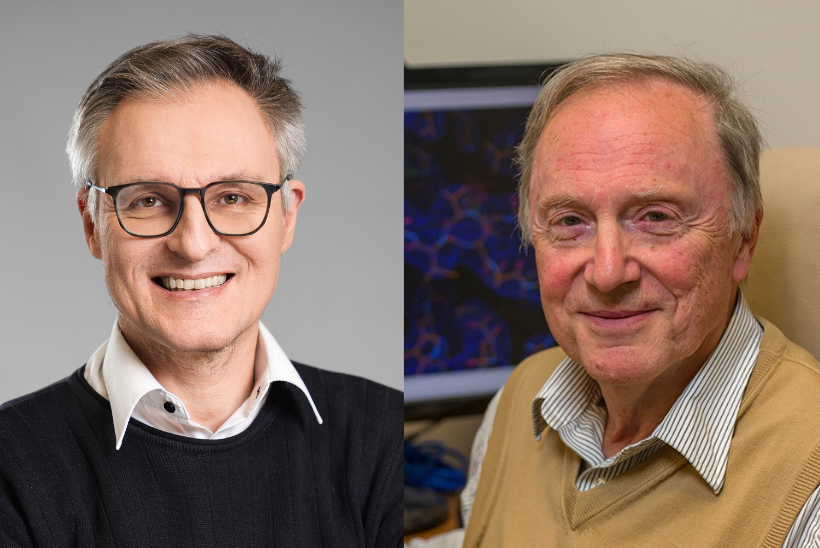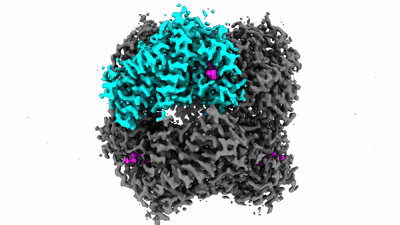A new enzyme important in DNA and RNA metabolism identified – publication in PNAS
Scientists from the International Institute of Molecular and Cell Biology in Warsaw described in the PNAS journal the function of a previously poorly understood enzyme, CDADC1. This enzyme is involved in regulating the availability of nucleotides required for the synthesis of DNA and RNA, and its activity may be important for the proper course of genetic processes.
DNA, the foundation of life, is found in nearly every cell. The genetic information it carries can be utilized through its translation into RNA. This, in turn, leads to the formation of proteins that build and drive the entire organism.
DNA and RNA are composed of three shared types of nucleotides: adenine, cytosine, and guanine (A, C, G). Additionally, DNA contains thymine (T), while RNA contains uracil (U). When a cell needs to copy DNA (for example, before division) or produce RNA (a transcript needed for protein synthesis), it requires specific building blocks – so-called nucleotides – that serve as the material for forming new strands. Numerous reactions are constantly taking place in cells, in which one nucleotide is converted into another. Many enzymes are involved in this process, collectively maintaining a balance between various types of nucleotides – which is crucial for the proper function of genetic processes.
Although the structure and function of DNA have been intensively studied for decades, nucleotide metabolism has long remained in the background – most knowledge in this field dates back to the 1960s and 1970s. The first author of the PNAS publication, Dr. Anton Slyvka from IIMCB, explains that research on nucleic acid metabolism involves analyzing the formation and conversion of the nucleotides that make up DNA and RNA.
“Nucleotide metabolism is a classical field of biochemistry, extensively studied in the mid-20th century. Between the 1930s and 1960s, many key reactions and enzymes were discovered, and earlier studies on the components of nucleic acids paved the way for the discovery of DNA structure in 1953. Over time, nucleotide metabolism came to be seen as largely understood, and scientific interest shifted toward molecular biology and genetics,” said Dr. Slyvka.
The IIMCB team’s research returns to the foundations of nucleic acid biochemistry – showing the function of the deaminase enzyme CDADC1, which in the cell converts cytosine into uracil. Deamination is a reaction in which an amino group is removed from a molecule and replaced by an oxygen atom, altering its properties – for example, converting cytosine into uracil. To be used as building blocks for DNA, nucleotides must first be converted into their triphosphate forms (e.g., dATP, dTTP, dGTP, dCTP). The team showed that CDADC1 is the first known example of deamination at the triphosphate level in eukaryotes, including humans.
It turns out that this previously unknown protein – CDADC1 – is commonly present in the cells of vertebrates, from sharks to humans. And if a protein involved in DNA and RNA synthesis has remained unchanged over hundreds of millions of years of evolution, it suggests that its role in the organism is extremely important. The IIMCB team therefore decided to study the activity and structure of this previously uncharacterized human deaminase. The scientists confirmed that the protein participates in nucleic acid metabolism.
 Fot. Research team: from the left: Anton Slyvka (IIMCB) oraz co-authors from the USA: Ishan Rathore from Center for Structural Biology, National Cancer Institute, NIH, Frederick National Laboratory for Cancer Research,
Fot. Research team: from the left: Anton Slyvka (IIMCB) oraz co-authors from the USA: Ishan Rathore from Center for Structural Biology, National Cancer Institute, NIH, Frederick National Laboratory for Cancer Research,
Tapan Kanai and Renbin Yang - both from Cancer Research Technology Program, Leidos Biomedical Research Inc. Frederick National Laboratory for Cancer Research. (Photo: Anton Slyvka)
But that is not all. As part of the study, the researchers bred mice lacking active CDADC1 protein. These mice developed normally – they were healthy and fertile, which suggests that the physiological role of this protein remains unclear. “We studied the mice under laboratory conditions, where the animals were not exposed to stress. It is possible that the significance of this protein emerges only under stress conditions. Further studies on the biological function of CDADC1 are ongoing. In this work, we focused mainly on the biochemical and molecular basis of its activity,” explained Dr. Slyvka.
“More than 20,000 proteins have been identified in humans, but the exact function is known for fewer than half of them,” said Dr. Slyvka.
 Photo: Research teams worked under the supervision of Prof. Matthias Bochtler (left), Head of the Laboratory of Structural Biology at IIMCB (photo: IIMCB), and Prof. Alexander Wlodawer from the National Cancer Institute at the National Institutes of Health (photo: Wikipedia by Wlod46, licensed under CC BY-SA 4.0. Modified.)
Photo: Research teams worked under the supervision of Prof. Matthias Bochtler (left), Head of the Laboratory of Structural Biology at IIMCB (photo: IIMCB), and Prof. Alexander Wlodawer from the National Cancer Institute at the National Institutes of Health (photo: Wikipedia by Wlod46, licensed under CC BY-SA 4.0. Modified.)
Currently, research mainly focuses on proteins with known relevance to health, as they hold the greatest potential for practical applications. “Studying unknown proteins carries a risk – their function may be of little importance from an application standpoint. Often, however, their significance becomes apparent only over time. In my view, discovering a new biochemical mechanism is a valuable contribution to science, even if its physiological role is not yet understood. It is worth studying phenomena that are scientifically interesting, even if their usefulness is not immediately obvious,” he concluded.■
Source: naukawpolsce.pl
Artykuł naukowy w PNAS jest dostępny bezpłatnie pod adresem: https://www.pnas.org/doi/10.1073/pnas.2424245122


